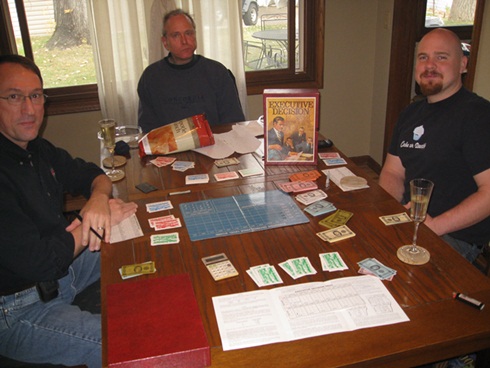

3M, 1971, 2-6 players, ages 12 and up. Another in the series of 3M "Bookshelf" games created by prolific game designer Sid Sackson, Executive Decision is a relatively straightforward exercise in manufacturing supply and demand. The game is played out over a variable number of months (decided upon by the players before play commences). Players are given a small stack of money and the first month begins. Each month is divided into two phases - acquire raw materials and build goods.
In the acquisition phase, players place secret bids for each of the game's three raw materials ("Extra Fine", "Fine" and "Standard"). Players are limited in the total number of raw material cards they can purchase during a given acquisition phase (determined by the number of players in the game). In addition to writing down how many of each type they wish to purchase, players must also specify how much they are willing to pay for them. This is where things get interesting. Each raw material has a starting value (with Extra Fine costing the most at the start of the game and Standard costing the least). Said prices for each raw material then go up or go down once the actual bids are revealed (up if the bid requests for a given raw material exceed 12 total units, and down if there are fewer than 12 bid requests). These price changes are then permanantly recorded on the main board and become the starting prices for the next month.
Since whatever you bid is how much you will eventually pay once all the market changes have played out, the goal (quite naturally) is to predict the new price exactly. If your "willing to pay" price is too high, you've just wasted money. On the other hand, if your bid price is too low, you are precluded from purchasing any of that material this month. Worse still, if you somehow overbid your money stockpile, all of your purchases of all materials are cancelled for the month.
Once all the raw materials have been paid for and the corresponding cards collected, players then move on to the production phase. Players decide what they want to produce based on the raw materials required to produce them and what they have available. An "A" good requires 2 extra fine and 1 fine, a "B" requires 1 extra fine, 1 fine and 1 standard, and a "C" requires 1 fine, and 2 standard. Players may substitute higher grade raw materials for lower grades if they so desire (IE, a "C" could be produced using 3 extra fines). Not surprisingly, the starting market price for "A" goods is higher than the starting price for "B" goods. Similarly, "B" goods having a higher starting price than "C" goods.
As in the purchase phase, players once again write their plans down in secret - choosing how many of a given good they will be producing and the lowest price they are willing to accept for each. The market then readjusts based on the proposed production of all the players (lots of production lowers the current market price for a given good, and little production increases it). These price changes are permanant and become the starting prices for the next month. And once again, the goal here is to read everyone else's mind and predict the exact market price. Go too low and you've left money on the table. Go too high and you sell nothing.
Once all the production has been sorted out, players cash in the raw materials that were actually used to produce goods (if any), collect the money for selling said goods, and then move on to the next month (IE, back to the purchase phase).
This is a fairly entertaining game, and one that's easy to learn and plays quickly. And it's really the whole "try to read everyone else's mind" aspect that provides much of the fun. It's absolutely crippling to go an entire month without producing any goods (IE, earn no new money), so predicting the purchase market becomes particularly critical. The temptation is to try to put too fine a point on one's price predictions, only to miss out on a purchase (and thus the eventual production) because you went too low. Then again, if you're overbidding all of your raw materials to the point that selling them isn't netting you much money, you're also in trouble. So, despite the fairly simplistic nature of the game, there's a fair amount of strategy here. I guess my only gripe is Sid Sackson's tendancy to "genericize" everything. Things would be a lot more entertaining (and easier to keep track of) if the raw materials were something more specific than "Extra Fine", "Fine", and "Standard", and the goods were something more real-worldy than "A", "B" and "C".